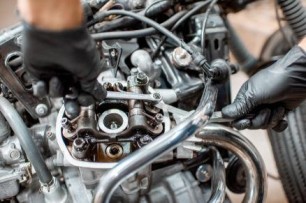General Insurance Blogs, Articles & Updates by - Magma HDI
Have us call you
- RENEW YOUR POLICY
- BUY NEW POLICY

Here are a few tips to change your bike's engine oil
No experience in life can compare to the adrenaline rush of riding a motorcycle. However, it is crucial to note the importance of maintaining your two-wheeler. Regularly changing the engine oil in your bike's motor is a vital part of keeping it functioning and operating smoothly. Without frequent oil changes, it overheats, the friction between its internal components increases, and overall performance suffers. As a bike owner, you must ensure that your bike's oil is changed regularly.
Yet another way to keep your bike safe is to cover it against any unexpected incident, such as damage, robbery, loss, or natural calamities, with the help of ideal 2 wheeler insurance.
Here are some important steps to change a bike's engine oil.
1. Start your engine:
It's a lot simpler to replace your oil while your engine is warm, so make sure you run it for at least 30 minutes before starting to change the oil. Remember, do not start a motorcycle and leave it idle. You will face the risk of causing damage to your bike.
2. Removal of old oil:
The next step is to dispose of the leftover oil by gently emptying it into a drain pan. The pipes from which the motorcycle oil is to be unloaded are positioned differently on various models, so be sure about the correct pipe before you begin.
Bend the motorcycle at a 45-degree angle and maintain it there for a few minutes. With a wrench, release the drain bolt and allow the oil to drain. Don't stop until you are confident there is no more oil left inside.
3. Install a new oil filter:
Be cautious while removing the old oil filter since there may be some spills. Before changing it, apply a little fresh oil to the new filter. This will guarantee that it runs smoothly into the engine and is readily withdrawn during the new oil filter replacement. Screw-in the fresh oil filter by hand, and be careful not to over tighten it.
4. Fill in the fresh motor oil:
Using the repair instructions manual that comes with your bike, measure out the exact quantity of oil required in a beaker. Remove the engine oil valve nut and insert a funnel to help the oil flow. Then, add the carefully measured oil to the engine.
Start the engine without revving it and let the fresh oil flow. With the completion of this step, you have successfully finished the procedure of changing the engine oil of your bike.
5. Finishing adjustments:
There are still some things remaining after the procedure. Ensure that there are no leaks and double-check all the bolts to assure they are snug. Wipe off any residual oil from the bike's surface using a cloth.
Bike owners have a close affection for their two-wheelers. As a result, they are not hesitant to get their hands dirty if it means keeping their bike in top condition. While an oil change ensures more remarkable performance, it does not protect from external causes or physical damages. Hence, responsible bike owners must invest in 2 wheeler insurance for the assured safety of their bike and good financial coverage if they incur loss due to accident or theft.
Click HERE to buy two-wheeler insurance.
Disclaimer: The information provided above is for illustrative purposes only. To get more details, please refer to policy wordings and prospectus before purchasing a policy.

Here are a few tips for installing an audio system in your car
We all love good music, especially while driving around or travelling long distances. The music system has become an essential factor associated with the purchase of cars. Vehicles today come with fancy sound systems, and their features differ with the price range and models.
The sound system has evolved massively over time. The type of speakers, the sound they produce, and different settings are now being provided in all kinds of cars. The modern intelligent and hands-free voice-enabled audio systems have raised car owners' bar.
In this blog, we will discuss the audio setup for your vehicle and a few tips for installing an audio system.
1. Stereo:
You need to figure out the stereo you are looking for. List all your expectations from the one you want to install. It could include multiple features like touchscreen, playback (video), navigation, etc. You can purchase a stereo (aftermarket) and get it installed by an expert technician to ensure that the wires are not altered, and the warranty doesn’t void.
2. Speaker:
Your current speakers might lack treble bass and dull the vocals. You can resolve this issue by getting a new speaker according to your needs. There are component speakers with two-way or three-way components.
The two-way speakers produce mid-low bass and vocals frequencies, while the three-way component speakers have an additional speaker for middle-range frequencies. You can also pick the full-range speakers, mainly known as the co-axial speakers, for an immersive audio experience.
3. Amplifier:
To achieve loudness from your speakers, you can add an amplifier to your audio system. It comes in various configurations and power outputs. Some of these configurations are 4/3/2 channels which consist of four-channel amplifiers: these amplifiers power one subwoofer or one subwoofer and two speakers or four speakers. You need to get a component subwoofer if you like loud, thumping bass or sub-bass in the songs.
4. Subwoofer:
The customisable option amongst subwoofers is the component subwoofer. It has a wide range of power ratings and sizes options. Bass tube and bass box subwoofers are preinstalled in tube type and bass box type enclosures. You can directly use them to plug and play.
Another option in this category is the under-seat subwoofer. They focus on bass and space utility as they can be easily installed under your seats, thus freeing up the boot space of your vehicle.
You can use some damping sheets on the doors, windows, floors of your car to lessen the background noise from the roads and reduce the vibration from the doors due to loud volumes. This would amplify the impact of the music.
That’s a wrap on the tips to install an audio system in your car. Adding to this, it would be wise if you refrain from listening to loud music while driving. It may distract you, and an unstable focus on the road can lead to severe mishaps. Along with installing an audio system, consider getting your car insured to safeguard it against damages and stay stress-free monetarily. Invest in suitable private car insurance India and ensure the longevity of your vehicle.
Click HERE to know more about buying private car insurance India.
Disclaimer: The information provided above is for illustrative purposes only. To get more details, please refer to policy wordings and prospectus before purchasing a policy.

Five ways to help your child choose the right career
As a parent, the responsibility to help your child choose the right career can be challenging. In the past, Indian society has noticed parents putting their children under tremendous pressure by comparing them to other children.
Nevertheless, parents have become aware of the importance of helping their children pick the right career. When your child passes out from high school, the next step is to decide which career will be best for them. We have got you covered!
In this blog, we will discuss five ways to help your child choose the right career for them.
1. Always treat your child as an individual rather than forcing your choices on them:
Even though your child came through you, they may not hold the same likes and dislikes as you. Unfortunately, many parents do not understand their child's likes and dislikes and want them to pursue careers that they couldn't when they were young.
However, doing so can affect your child's mental health and mislead them in the wrong direction. Instead, try to understand their views without belittling them. Their dreams and aspirations should be your priority.
2. Help them find their interests:
Some children may have a firm decision about the career they want, while others may be confused. Encourage your child to find what interests them. You can list down all the things they like and dislike. You may also motivate them to analyse their strengths and passions.
3. Get professional help for your child:
Sometimes, picking the right career can become challenging due to a lack of understanding between the child and parent. Therefore, provide professional help to your child by connecting them to counsellors who can conduct their aptitude test and guide them about which field interests them and what career prospects can be the best for them.
4. Help them explore all the options:
As a parent, you will be aware of your child's hobbies, dislikes, and likes. For example, if your child is already excelling in painting, you may encourage them to explore their options. Help your child explore all the possible career options that let them enjoy their passion. Remember not to go too far, as it can be overwhelming for them. Figure out the right time to discuss it with your child and slowly approach the conversation.
5. Be encouraging and patient during the process:
Choosing the right profession does not happen overnight. Humans evolve with time. Remind your child that it is alright to take their time to explore their interests.
If your child wants a break for their self-discovery journey, do not demotivate them. Instead, encourage them to keep exploring their options and pick the ones they like.
When helping your child pick the right career option for them, you need to have a lot of patience and strength. This process and such a wide array of options can be overwhelming and frustrating for your child, which can cause them to become anxious. However, you can support your child by encouraging them to take their time to figure out their options.
Help your child pick the right career without putting them under pressure or treating them as an extension of you. A secure future is also essential for your child. Invest in general insurance and shield your child's aspirations and health, all under one comprehensive cover. Look for online general insurance to get multiple options and benefits.
Click HERE to get online general insurance for your child to ensure their well-being and safety.
Disclaimer: The information provided above is for illustrative purposes only. To get more details, please refer to policy wordings and prospectus before purchasing a policy.

How early immunisation can help your infant have a healthy life
For more than five decades now, immunisation has saved billions of lives. It's a low-cost, high-impact strategy to safeguard your child's health against various diseases and infections. Immunisation builds the groundwork for a healthy future.
Vaccines are critical in protecting the most vulnerable, such as children and infants. However, one out of every five children in the world is still unvaccinated. Having the highest number of unvaccinated children, India has strengthened its efforts to enhance mass vaccine coverage with mission Indradanush 2.0.
Over the last few decades, healthcare has become increasingly expensive. A health insurance policy can come in handy during costly treatments and hospitalisations. So, look for online health insurance companies to buy a policy to secure your child's future and cover them under seamless benefits. To find out more about immunisation, continue reading this article.
What is immunisation?
Immunisation is the process that protects people against illness caused by microorganism infection (formally called pathogens) by increasing the immunity of the body to combat these infections. A vaccine is a biological substance used for immunisation.
How does immunisation work?
When immunised against a disease, your body treats it as a natural infection. A vaccine contains a microorganism that is introduced into the body in a dead or weakened form. However, your immune system has no way of knowing whether the virus is alive or dead, so it takes it as a red alert and treats it as a threat. As a result, the immune system produces antibodies to attack the virus and eliminate it from the body.
As a result, if you acquire a similar virus in the future, your immunity will be prepared to combat that virus and shield your body against its infection. According to a World Health Organization report, immunisation saves an estimated 2-3 million lives each year (majorly children) by protecting against diphtheria, pneumonia, pertussis (whooping cough), rotavirus, diarrhoea, rubella tetanus, smallpox, polio, mumps, and measles.
Immunisation has eradicated many terrible diseases that massacred people in clusters and tons. Despite this, an estimated 19.5 million infants have not received all immunisations. The need to adequately communicate the health advantages of vaccination and the risks of not immunising children cannot be overstated.
Importance of early immunisation:
Most health experts, researchers, and professional medical organisations strongly recommend immunisation. Vaccines are the most effective steps to prevent infectious diseases.
Vaccine-preventable diseases are known to induce childhood stunting, leading to poor growth, poor adult health, and lower learning ability in children. But, getting your infant vaccinated at the right time can prevent them from having to experience such situations.
Vaccinations are an essential factor in determining your children's health. Shots for children are only effective if they are given on time and according to schedule. They aid in developing children's immune systems, allowing them to grow up healthy and happy. The development of cognitive abilities is also observed after vaccination.
Alongside vaccination, it is essential to buy comprehensive health insurance for your child to secure their health and life further. You may look for online health insurance companies and browse through different plans, compare their premium, and then choose the one that fits all your requirements.
Click HERE to know more about health insurance.
Disclaimer: The information provided above is for illustrative purposes only. To get more details, please refer to policy wordings and prospectus before purchasing a policy.


